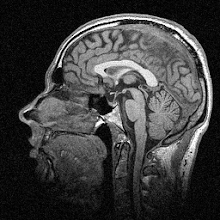How do we learn to make reaching movements in the presence of destabilizing perturbations? The standard way of thinking about this assumes that if you misreach, your motor system will notice the error and get better next time, whether it’s through recalibration of the sensory system or through a new cognitive strategy to better achieve the goal. But this paper from Diedrichsen et al. (2010) postulates another learning mechanism than error-based learning: something they call use-dependent learning.
The basic idea is that if you’re performing a task, like reaching to an object straight ahead, and you’re constantly getting pushed off to the side, you’ll correct for these sideways perturbations using error-based learning. But you’re also learning to make movements in the non-perturbed direction, and the more you make these movements the more experience you have with making these kinds of movements, so each movement becomes more similar to the last.
The authors demonstrate this with some nice experiments using a redundant movement task – rather than moving a cursor to a target as in standard motor control tasks, participants had to move a horizontal bar up the screen to a horizontal bar target. The key thing is that it was only the vertical movement that made the bar move; horizontal movements had no effect. In the first experiment, participants initially reached to the bar before being passively moved by a robotic system in one of two directional tilts (left or right) and were then allowed to move by themselves again. The results are below (Figure 1 in the paper):
Redundant reaching task
You can see that after the passive movement was applied, the overall angle changed depending on whether it was to the left (blue) or right (red). Remember that the tilt was across the task-redundant (horizontal) dimension, so it didn’t cause errors in the task at all! Despite this, participants continued to reach in the way that they’d been forced to do after the passive movement was finished – demonstrating use-dependent learning.
To follow this up, the authors did two more experiments. The first showed that error-based and use-dependent learning are separate processes and occur at the same time. They used a similar task but this time rather than a passive movement participants made active reaches in a left- or right-tilting ‘force channel’. This time the initial angle results showed motor aftereffects that reflected error-based learning, while the overall angle showed similar use-dependent effects as in the first experiment.
Finally they investigated use-dependent learning in a perturbation study. As participants moved the bar toward the target they had to fight against a horizontal force that was proportional to their velocity (i.e. it got bigger as they went faster). Compared to a ‘standard’ perturbation study (a reach to a target, where participants could see their horizontal error) the horizontal errors weren’t corrected after learning. However, the initial movement directions in the redundant task were in the direction of the force field – meaning that as participants learnt the task the planned movement direction changed through use-dependent learning.
I think this is a really cool idea. Most studies focus on error as the sole basis for driving motor learning, but thinking about use-dependent learning makes sense because of what we know about how the brain makes connections through something called Hebbian learning. Basically, though an oversimplification: ‘what fires together, wires together’, which means that connections tend to strengthen if they are used a lot and weaken if they are not. So it seems reasonable (to me at least!) that if you make a movement, you’re more likely to make another one like it than come up with a new solution.
It also might explain something about optimal feedback control that I’ve been thinking about for a while since seeing some work from Paul Gribble’s lab: we often talk about the motor system minimizing the energy required to perform a reach, but their work has shown pretty conclusively that the motor system prefers straight reaches even if the minimum energy path is decidedly not straight. There must therefore be some top-down mechanism that prioritises ‘straightness’ in the motor system, even if it’s not the most ‘optimal’ strategy for the task at hand.
Lots to chew over and think about here. I haven’t even covered the modelling work the authors did, but it’s pretty nice.
---
Diedrichsen J, White O, Newman D, & Lally N (2010). Use-dependent and error-based learning of motor behaviors. Journal of Neuroscience, 30 (15), 5159-66 PMID: 20392938
Image copyright © 2010 Diedrichsen, White, Newman & Lally













